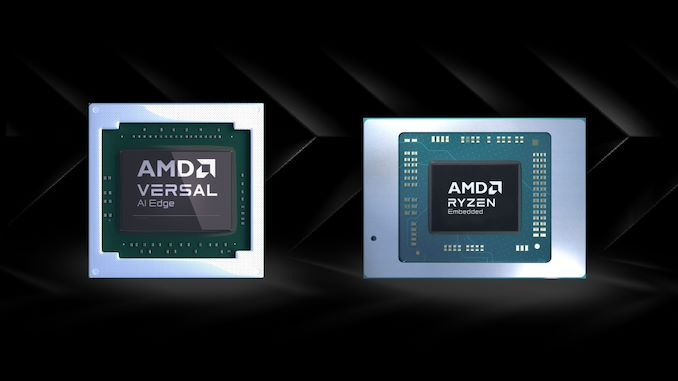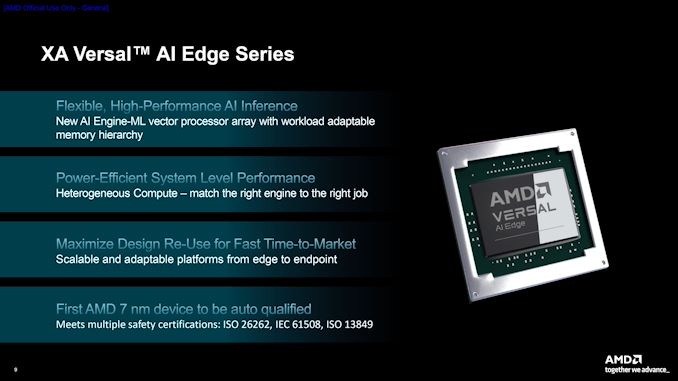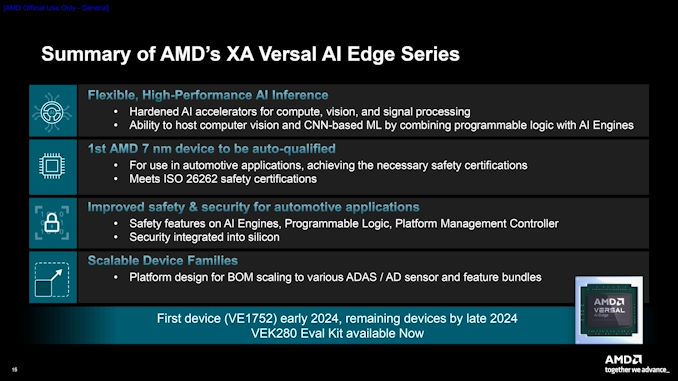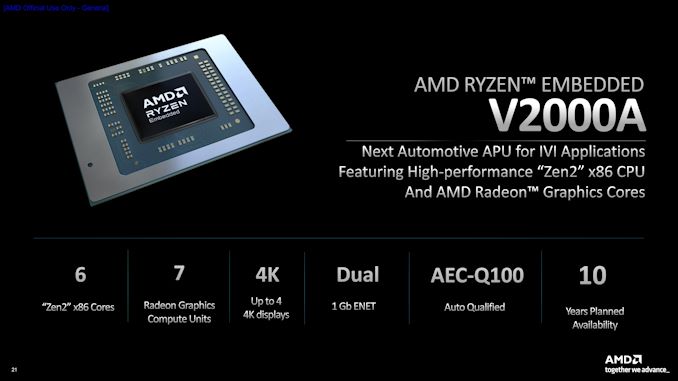AMD Unveils XA Versal AI Edge and Ryzen Embedded V2000A For Automotive
by Gavin Bonshor on January 4, 2024 9:00 AM EST- Posted in
- CPUs
- AMD
- Edge
- Trade Shows
- Automotive
- Ryzen
- NPU
- AI
- Ryzen Embedded
- Versal
- CES 2024
- V2000A

With CES 2024 fast approaching, AMD has announced two new products designed to enhance user's experience in the automotive sphere. The first is the XA Versal AI Edge series, their first 7 nm device to be automotive qualified, with a new AI engine and vector processor array designed to drive safety and improve LiDAR, radar, and cameras, all while driving more AI inferencing within a vehicle.
The second is the AMD Ryzen Embedded V2000A series of processors, designed to deliver a paradigm shift in digital cockpits, enhance driver experience, improve in-car entertainment, and have higher levels of media focused performance. Both AMD's XA Versal AI Edge and the Ryzen Embedded V2000A series promise to deliver a much more enhanced user experience, whether that be drivers reliant on digital and AI-assisted safety features as well as passenger entertainment as we go into what is set to be a pivotal year for AI.
AMD XA Versal AI Edge: Scalable From Edge to Accelerators
Perhaps one of the most significant talking points within the industry, and outside of it, is AI and how it looks to transform how we do things. While machine learning and generative AI are two main topics, how we use AI and how companies adopt it into their software and designs are critical as we head into 2024. AI isn't just about making things better; it's a tool that brings many benefits through things such as generative AI. Within the PC industry, both Intel (Meteor Lake) and AMD (Ryzen AI) bring on-chip inferencing to the PC market; AMD is bringing a more robust approach to the automotive industry, specifically within digital cockpits of new vehicles for those on the go with XA Versal AI Edge.
At the core of the AMD XA Versal AI Edge series lies AMD's first 7 nm device to achieve automotive qualification. This milestone underscores AMD's commitment to innovation and ensures that the series meets the stringent standards required by automotive applications. The significance of this comes through the ability of the XA Versal AI Edge series to seamlessly integrate into modern vehicles' ever-growing and complex ecosystem. The XA Versal AI Edge chip comes through AMD's acquisition of Xilinx in 2022, bringing many advancements to AMD's portfolio, including their client-focused Ryzen AI engine block within the latest Ryzen 8040 series of mobile processors.
With XA Versal AI comes a new vector processor array specifically designed to drive more comprehensive automotive safety features to the market. By improving the functionality and efficiency of crucial components such as LiDAR, radar, and cameras, the XA Versal AI Edge series enhances precision and responsiveness to vehicle systems. This is particularly vital in AI inferencing within a vehicle, where split-second decisions based on accurate sensor data can differentiate between safety and what could be an absolute disaster, such as a crash or collision.
The XA Versal AI Edge series has improved AI inferencing capabilities and is designed to boost the vehicle's ability to navigate and interact with its surroundings. This helps pave the way for more advanced autonomous driving features, with lower real-time processing and lower latencies providing benefits while driving. By processing vast amounts of data in real-time, the XA Versal AI Edge chips enable a more responsive interaction between the vehicle and the driver. This translates to a faster and more secure ecosystem, which enhances both the driver's and passengers' confidence in the vehicle's capabilities.
One advantage of AMD's XA Versal AI Edge solutions is their scalability, with their lead model, the XAVE2602, combining 152 AI Engine tiles with 820k logic cells, as well as 984 Digital Signal Processors (DSP), with AMD claiming up to 89 TOPS of INT8 performance across the AI engine, the DSP and Programmable Logic. There are options ranging from 5 TOPS to 171 TOPS, with seven options for different devices and markets. At the heart of AMD's XA Versal AI Edge chips are a dual-core Arm Cortex A72 APU and a dual-core Arm Cortex R5F RPT unit, which range from 6-9 W (XAVE2002) up to a potent 75 W (XAVE2802) estimated power usage. It's worth highlighting that all of AMD's TOPS figures for their XA Versal AI Edge chips are estimated by AMD engineers and aren't verified externally.
Having a varied level of scalability from the same Arm Cortex Dual-Dual core pairing allows AMD to accommodate varying levels of devices, from LiDAR sensors to radar and regular cameras. It also means AMD only needs one design that scales with the same tooling, software, and general ecosystem so that manufacturers using these Versal AI Edge chips can select the one that suits their performance needs. Another element to consider is that as devices scale into better designs, their iterations are on the same platform, meaning a new product design can be created using the same overall ecosystem.
Ryzen Embedded V2000A: 7 nm with Zen 2 Cores
Moving to the second of AMD's automotive-related announcements for CES 2024 is the Ryzen Embedded V2000A series. This new line of processors is designed to initiate the emergence of AI within the digital automotive cockpit. Designed to meet the evolving needs of both drivers and passengers, AMD has designed the V2000A series to deliver higher performance, enhancing multiple aspects of the in-car experience. Ryzen Embedded V2000 is not a mere incremental upgrade but represents a shift in how users can interact with and use vehicle entertainment and infotainment systems.
Replacing the previous Zen-based 4C/8T V1000 APU, the new Ryzen Embedded V2000A series is designed to handle the complex requirements of advanced driver interfaces and in-car entertainment systems. The results in improved graphics quality and a faster response to user inputs, leading to a smoother interaction with the vehicle's systems. For drivers, this means more intuitive control panels and heads-up displays and enhancing access to critical information and controls with minimal distractions. Passengers also benefit, with the series supporting high-definition streaming and gaming experiences, elevating the overall in-car entertainment experience to levels similar to home or mobile platforms.
The Ryzen Embedded V2000A series is built on the 7 nm manufacturing process and, as a result, uses Zen 2 cores combined with AMD's Radeon Vega 7 graphics. Featuring up to 6C/12T with Zen 2 cores, with 7 CUs of Radeon Vega graphics, the Ryzen Embedded V2000A has support for up to four 4K displays, with dual Gigabit Ethernet, and is AEC-Q100 automotive qualified. Looking ahead to the next generation of automotive silicon and with AI as a key selling point, Ryzen Embedded V2000A has a planned availability of 10 years, which ensures companies and automotive partners adopting V200A into their vehicles are guaranteed availability.
Some of AMD's partners onboard with XA Versal AI and Ryzen Embedded V2000A include notable electric car maker Tesla, with Ecarx, Luxoft, BlackBerry/QNX, Xylon, and Cognata also looking to implement these new chips into their automotive products.
AMD states that the first device, the XAVE1752, will be available in early 2024, with the remaining devices coming to market before the end of 2024. AMD also notes that the AXVEK 280 Evaluation Kit is now available to partners and manufacturers. AMD will demonstrate their XA Versal AI Edge at their booth, among other automotive solutions, at CES 2024. For reference, the AMD booth is located at the Las Vegas Convention Center (LVCC) within the West Hall at #W319.























13 Comments
View All Comments
meacupla - Thursday, January 4, 2024 - link
I liked the slide that says "... supports AAA gaming with a dGPU ..."I would guess that model doesn't require a heater core for winter.
Threska - Thursday, January 4, 2024 - link
"Replacing the previous Zen-based 4C/8T V1000 APU, the new Ryzen Embedded V2000A series is designed to handle the complex requirements of advanced driver interfaces and in-car entertainment systems. "Now all we need is the one for autonomous vehicles.
zetruz - Saturday, January 6, 2024 - link
In-car entertainment systems? Would this then actually do video playback in some situations? With a 10-year availability lifespan, that'd be a terrible choice given no AV1 support.Zok - Thursday, January 4, 2024 - link
"One advantage of AMD's XA Versal AI Edge solutions is their scalability, with their lead model, the XAVE2602"AMD's slide points to the XAVE1752 as the "lead model". Which is it?
dotjaz - Thursday, January 4, 2024 - link
Lead can mean flagship or first to market, based on CONTEXT. You are clearly mixing the two.kn00tcn - Thursday, January 4, 2024 - link
surprisingly not zen3, still vega because rdna1 was skioped in apus, stuck with this for a decade...what OS do these run on? who makes the drivers? do car brands release updates promptly? what is the witcher running on or ported to? dgpu mentioned so i guess this is beyond cars
dotjaz - Thursday, January 4, 2024 - link
AMD has no problems supporting Linux driver with no game tuning. They all run UNIX-like systems and dGPU can be used in cars.kpb321 - Thursday, January 4, 2024 - link
Zen 2 seems to be sticking around in these situations for a Quad core and lower setups. Zen3 moved to a 8 core CCX and AFAIK all Zen3 based products have kept that. For things like lower end laptops or here where they may be expecting a lot of volume in 2 or 4 core chips using a 8 core CCX is going to be pretty expensive and wasteful. Interestingly Zen 4 seems to be more flexible in that regard as they've done Zen 4 APUs with 2 Zen 4 cores and 4 zen 4c cores so we may eventually see lower end chips with zen 4 or zen 4c cores and completely skip Zen 3 for those types of products.nandnandnand - Wednesday, January 10, 2024 - link
This V2000A has 6x Zen2 cores! Maybe two of them are reserved for non-gaming?webdoctors - Thursday, January 4, 2024 - link
Wondering if this is ASIL-D certified? Kinda low TOPS numbers though compared to the competition. Like bringing a knife to a gun fight....https://connecttech.com/orin-xavier-comparison/
https://www.counterpointresearch.com/insights/nvid...
Wonder why the power consumption so high for such a small chip, weird.